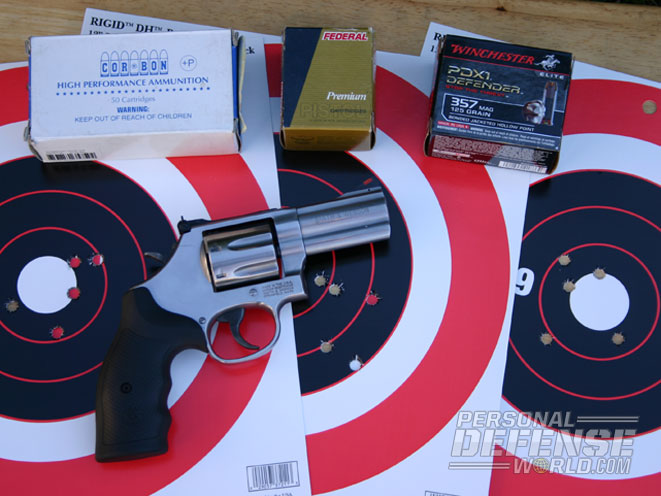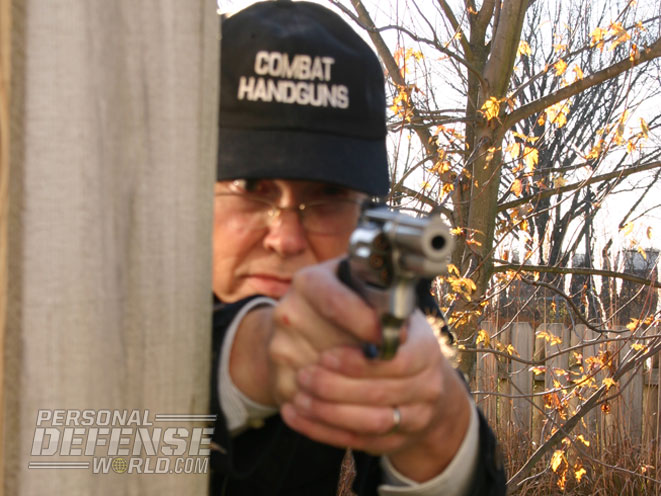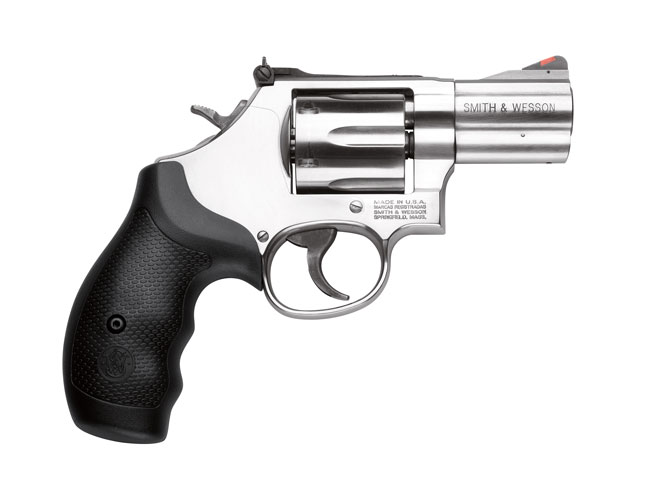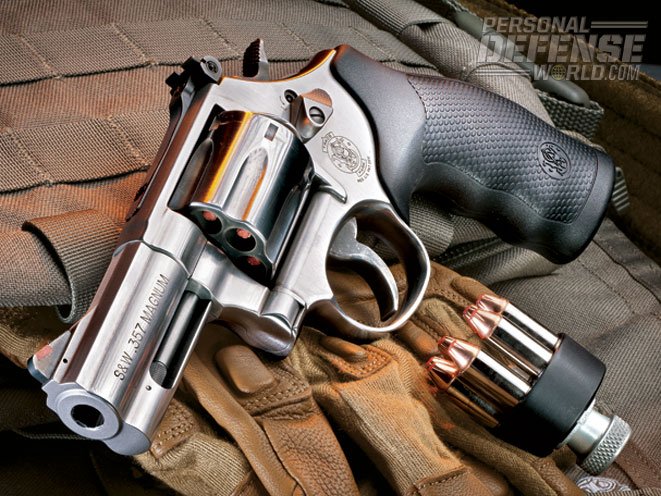When the .357 Mag was introduced by Smith & Wesson in 1935, the “platform” was a large, N-Frame revolver with a massive six-shot cylinder: the Model 27. Twenty years later, S&W brought out a medium K-Frame .357 Mag designated the Model 19, or Combat Magnum. According to U.S. Border Patrol Agent Bill Jordan, the weapon’s light weight and magnum firepower made it the “peace officer’s dream.” Back when I became a cop, the S&W Model 19 was the revolver ubiquitously seen in the holsters of state and local LEOs in my part of the country. Unfortunately, the Model 19 just did not hold up well to a steady diet of .357 Mag loads, so S&W cast around for a solution. In 1981 the company introduced the L-Frame revolver, a compromise between the big N- and medium K-Frame, with a beefed-up forcing cone area and topstrap, plus a larger cylinder to help handle the .357 Mag power. It also had a heavy barrel with a full-length ejector-rod shroud that went all the way to the muzzle to add some weight. Both fixed- and adjustable-sighted versions were available in blue or stainless (the 581/681 and the 586/686, respectively). It was given the moniker “Distinguished Combat Magnum.”
The revolver-oriented law enforcement world immediately saw the advantages of this new handgun and began to convert to the firearm in droves. I liked the idea of having one with fixed sights and, in late 1981, bought a Model 581; it was my last duty gun with the Jefferson Parish Sheriff’s Office before I went to the U.S. Border Patrol in 1982. In 1988, I began duty as an inspector with U.S. Customs, and the gun I was issued at the Federal Law Enforcement Training Center was the S&W Model 686 with a 4-inch barrel. At the request of Customs the gun had been made with closer tolerances and was referred to as the CS-1. If you could qualify with it, you could carry .357 Mag, 125-grain JHP loads, which I did. Later I swapped my gun for a CS-1 with a 3-inch barrel, a size I’ve always liked, as you can use the revolver for on- or off-duty carry and, unlike the 2.5-inch-barreled guns, the revolver has a full-length ejector rod.
RELATED: First Look! Smith & Wesson’s New M&P22 Compact
Advertisement — Continue Reading Below
In October 2012, I was in San Diego attending the International Association of Chiefs of Police (IACP) Conference, where I toured the product exhibition area. At the S&W display booth I went looking for new items. Among all the autoloaders like the M&P series handguns, in a small display section, I saw an old friend: a stainless steel, L-Frame .357 Mag revolver—but with a heavy, 3-inch barrel; new, more ergonomic rubber grips; and a “Plus” designation, meaning it had a seven-shot cylinder. This old friend was, in fact, a new variant. A big smile spread across my face, and I quickly made arrangements for a test gun.
Gun Details

The 3-inch-barreled S&W Model 686 Plus (stamped with a “686-6,” which I’ll use for short, and not to be mistaken for the 2.5-inch variant) came in a blue, plastic S&W carrying case with an instruction manual, a product registration card, a safety padlock and two little keys for activating the internal action-lock system, which comes standard with most S&W guns. I hefted the 686-6 and found it had a solid feel, good balance and, at 36.8 ounces empty, some weight. An external examination revealed a good fit and finish and no visible blemishes or mistakes from the polishing wheel. The stainless steel has a satin finish, the sights are black (the front blade has a red insert and the rear notch as a white outline), and the hammer and trigger are color casehardened. The black synthetic grip has pebbled side panels and finger grooves, with a relieved and contoured left panel for speedloader use. The grip fit my medium-sized hand a lot better than some of the grips S&W has used in the past.
Advertisement — Continue Reading Below
RELATED: 5 Smith & Wesson Guns for Everyday CCW Self-Defense
Unlike my old S&W Model 581 and CS-1, this new L-Frame has all the characteristics now common to S&W wheelguns, such as the frame-mounted firing pin, a new cylinder latch, an integral cylinder stop, a crush-fit barrel and a universal grip frame—plus the pesky internal action-lock with its abysmal keyhole just above the aforementioned latch. The hammer spur is 0.38 inches wide and nicely checkered for good thumb purchase when cocking the revolver for single-action shooting. It’s teamed with a 0.25-inch-wide, smooth-faced trigger, which is a good combination for double-action shooting. Like thousands of its siblings past and present, the 686-6 had a crisp, fairly light SA trigger pull. While the DA pull was smooth from start to finish, the pull weight had to have been in the 13- to 15-pound range but improved with use.

S&W’s L-Frame has become one of the most popular revolvers in the company lineup. Perusing the S&W website, I counted no less than 20 different models, including guns meant for law enforcement/security, personal defense, hunting and competition. Only the small J-Frame series seems to have more versions, but when you consider the L-Frame is only chambered for .357 Mag (and will also accept .38 Special +P), that’s pretty awesome and speaks well for the popularity of this intermediate-sized handgun. You might also consider that law enforcement in the last 25-plus years has done an almost complete reversal of its sidearm policy. When I began wearing a badge in 1976, seeing a uniformed cop with a semi-automatic pistol was a rarity. Now the situation is reversed, although you still tend to see wheelguns on the hips of security officers, armored-car guards, older LEOs and small agency cops out West. This trend greatly affects civilian handgun selection, so the fact that the L-Frame is hanging on in the form of some 20 variants says a whole lot about its continued utility.
Advertisement — Continue Reading Below
RELATED: Gun Review – The Timeless Smith & Wesson M&P Revolver
As for leather, duty, off-duty, plainclothes and personal-protection holsters abound for the S&W L-Frame. Of course, most holsters, unless they are special order, will be for short, 2.5-inch barrels or longer 4-inch-barreled L-Frames. My collection yielded two off-duty scabbards from Don Hume: a pancake-style holster for a 4-inch-barreled L-Frame and an ancient Agent 9 belt slide, which I’ve had for about 35 years but is so versatile that it remains one of my favorites—its open end will accept any barrel length. I also had a complete Uncle Mike’s ballistic-nylon duty rig that I used for a time with my CS-1, back in the day when Customs inspectors could carry personally owned weapons and related gear. In my collection I also found two HKS speedloaders stamped “#587” on the knob, each holding seven rounds for the Model 686 Plus. So you can see the 3-inch-barreled wheelgun’s versatility, which is much like that of today’s medium-sized autoloaders, such as the Glock 23 or HK P2000, that lend themselves well to on- and off-duty carry.
Range Time
Advertisement — Continue Reading Below

My old 3-inch-barreled CS-1 proved to be very accurate, so I had high hopes for the new S&W Model 686 Plus. I tested the revolver with three different .357 Mag loads, shooting five-shot groups at 15 yards from the bench to evaluate the accuracy potential. From my ammunition locker I pulled a box of vintage CorBon 125-grain JHPs. The box flap stated that the average velocity was 1,450 fps, so I was curious to see what I’d get out of the 686-6’s 3-inch barrel. I also had some Federal Premium ammunition with 158-grain Hydra-Shok HP bullets and some more recent Winchester PDX1 Defender ammo with 125-grain JHP bullets. The afore-mentioned ammo and the holsters/rig accompanied me to the range for a shooting session in early December, on an unseasonably mild day.
RELATED: Gun Review – Smith & Wesson’s Semi-Custom M&P .40
Advertisement — Continue Reading Below
The first order of business was to set up my Oehler Model 35P chronograph and get some velocity measurements. The CorBon load turned out to be a real beast with an average velocity of 1,405 fps. Next I set my target stand up at the 15-yard line and stapled up some generously sized bullseye targets. I’d done a gun test the previous week using some targets that caused me some eye strain, which decreased my accuracy, so I was determined to not repeat that mistake. Using a dead-center point of aim and shooting in SA mode, the two 125-grain JHP loads shot low and to the right, while the 158-grain Federal load had a more centered impact that was a tad low. I decided to adjust my hold rather than mess with the click-adjustable rear sight. My best five-shot group came from the Winchester PDX1 Defender rounds, with a cluster measuring 2.38 inches. However, I had a really tight, 1.85-inch, four-shot group going with the hot CorBon loads until a flyer opened it up to 3.31 inches. For full-bore magnums from a 3-inch barrel, the 686-6’s performance did not disappoint.

For a more practical accuracy and reliability assessment, I ran the 686-6 through a couple of combat qualification courses, using a mix of the .357 Mag test ammunition. The 30-round course I habitually use has been adapted from six-shot revolvers to autoloaders, but I had to do a little more modifying for a seven-shot wheelgun. As I was using a Q-B27P silhouette target with scoring rings, I eliminated the two headshots from the course requirement and only used a center-mass point of aim. Shooting began from the holster at 3 yards, using first one hand then the other for 12 rounds. In the process a reload had been required, so I still had two rounds in the cylinder. Moving to 7 yards, I fired a series of double-taps using a two-handed hold. I fired the two rounds I had, reloaded and fired four more. This set me up for the next stage, which was two triple-taps at 7 yards. Again I shot what I had in the cylinder, firing three rounds, reloading then firing three more. That left me with four rounds in the cylinder, and I still had to shoot six shots from the 15-yard barricade. I moved back and fired tow from the left-side barricade, took cover, reloaded then fired two shots while standing and two while kneeling. The remaining three rounds were extracted from the cylinder for the next go-around.
Advertisement — Continue Reading Below
RELATED: Gun Review – Smith & Wesson M&P Shield
The Q-B27P target has a blue, humanoid silhouette; however, there is a bowling-pin-shaped area in white that encloses the 8, 9, 10 and X rings, running upward into the 7 ring and mid-head area. I managed to keep all my shots in the white area using the 686-6 and the magnum ammo. With the scoring rings, my best effort yielded a 287-7X out of a possible 300 points. To say I’m a bit rusty with shooting a short-barreled magnum revolver and reloading with speedloaders would be an understatement. I would have been very disappointed in this score 20 years ago, but today I will happily accept it! Shooting a magnum revolver like the S&W Model 686 Plus with full-bore magnum cartridges is a lot different than shooting today’s newest-generation semi-auto pistols. The relationship of the bore to the top of the hand holding the weapon is generally much higher on the revolver. This bore axis can either add to or subtract from felt recoil and muzzle flip, which translates into the handgun’s potential for rapid-fire controllability. On a revolver, the design of the grip has a lot to do with controllability, and the 686-6’s ergonomic grip really helps.
Final Thoughts
Advertisement — Continue Reading Below

I believe that the Model 686 Plus, with its 3-inch barrel, is a most fitting addition to the S&W revolver lineup, one that is both practical and versatile. My test gun proved highly reliable; it handled well and possessed first-rate workmanship. If I could pack a revolver on my uniform duty belt once more, you can bet that this seven-shooter would be high up on my list of carry guns.
For more information, visit http://www.smith-wesson.com or call 800-331-0852.
Advertisement — Continue Reading Below























